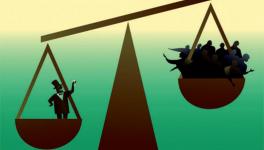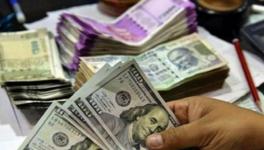Indian Economy is on the Road to a Stable State of Zero Growth

Adam Smith and David Ricardo had been haunted by the idea of capitalism ending up in a “stationary state”, by which they meant a stable state of zero growth. Marx used the term “simple reproduction” to describe such a state, where there is no net addition to production capacity and the economy just reproduces itself at the same level period after period. The Indian economy appears headed for such a state.
The Narendra Modi government’s propaganda machine, as usual, is working overtime to paint a rosy picture of the economy; but the reality is the very opposite. This propaganda uses a simple arithmetical trick. If output falls, say, from 100 to 90, then the fall is 10%; and then if it recovers next year to 100, then the increase is 11.1% (because of the lower base). The rate of increase (11.1%) being higher than the rate of fall (10%) allows the false claim that the economy has resumed its growth trajectory; in fact, it has shown no growth at all over the two-year period. Such a false claim is precisely what the government is resorting to.
Let us completely forget 2020-21, the year when the pandemic was acute, and just take the preceding and the succeeding year. Between 2019-20 and 2021-22, the gross domestic product in real terms increased by just 1.5%, which was lower than the population increase (2%) between these two years; per capita real GDP was thus lower in 2021-22 compared with 2019-20.
The ingredients that went into the making of this stagnation are worth examining. Consumption (namely, private final consumption expenditure in real terms) was about 1.5% higher in 2021-22 compared with 2019-20, while gross fixed capital formation in real terms (that is, gross investment in real terms other than changes inventories) was 3.75% higher.
The somewhat higher rate of growth of investment than of consumption was because of a bunching of investment projects that had been postponed from the days of the lockdown. It could also perhaps have been because of replacement and modernisation expenditure in some sectors. In either case, this higher rate cannot be maintained for long.
As the rate of growth of investment comes down, the rate of growth of consumption will come down too (because of what economists call the “multiplier” effect, namely, because the lower investment will reduce output and hence employment and consumption demand), which will push the economy even more emphatically towards a stationary state or simple reproduction. The economy, already virtually stagnating (and retrogressing in per capita terms) is thus moving firmly into a state of absolute stagnation (and hence even greater retrogression in per capita terms).
When the economy is in such a state of absolute stagnation, it becomes very difficult for it to get out of this state. The reason is simple. The total GDP is necessarily equal to private final consumption expenditure, plus gross investment, plus net exports (namely exports minus imports of goods and services), plus government consumption.
Let us for the moment ignore the last two items; let us also ignore that part of investment which is meant for producing goods and services for the export market. Then, if the economy is experiencing stagnation, there is no reason for consumption to increase, as it basically depends on the level of income; it would, therefore, continue to experience stagnation.
Investment, too, will not increase because there is no reason for firms to enlarge capacity, as the economy, and by inference the home market, has been stagnant. Unless, therefore, at least one of the three expenditure items that we have ignored so far, shows an autonomous spurt, namely a spurt autonomous of the home market, the economy will continue to remain mired in a state of stagnation (or even negative growth until a state of stagnation is reached).
Now, net exports will not suddenly show an upward spurt, as the world economy itself is stuck in stagnation, so that the external demand for Indian goods has no reason suddenly to increase; and under the neo-liberal regime the government will not suddenly impose high tariffs or other protectionist measures in order to reduce India’s imports.
Precisely for the same reason investment for the export market or for import substitution will not show any upward spurt. And as for government expenditure, since the government is committed to keeping the fiscal deficit in check, as a proportion of GDP, unless tax revenue as a proportion of GDP increases suddenly, government expenditure can hardly show a trend different from GDP.
Even here if tax revenue as a proportion of GDP rises because of indirect taxation which largely impinges on private consumption, there will be no net addition to demand: the rise in government consumption as a proportion of GDP in this case will be largely offset by a fall in private consumption as a proportion of GDP. Exactly the same holds for government expenditure financed by larger direct taxes imposed on that segment of the population which consumes the bulk of its income.
Only that increase in government expenditure, therefore, can have the effect of overcoming the state of stagnation which is financed either through a larger fiscal deficit relative to GDP, or through an increase in the rates of direct taxes on the rich. The latter course includes either larger taxes on corporate incomes or larger taxes on private wealth. But these ways are precisely what the government has steadfastly refused to follow. It has remained more or less committed to the fiscal deficit limit; and, far from larger taxes on the rich, it has been giving tax-concessions to the corporate sector in the utterly mistaken belief that such concessions will revive the economy by increasing investment.
This belief is mistaken for two reasons. First, even assuming, for argument’s sake, that corporate investment increases through such tax concessions, this will be offset by the reduction in government expenditure owing to reduced government revenue, thereby preventing any net increase in aggregate demand and hence thwarting any revival of the economy.
Second, corporate investment depends on the growth of demand in the economy and not on tax concessions; if demand in the economy is not increasing, then tax concessions given to capitalists are simply pocketed by them without their undertaking any additional investment.
It follows that if the economy is caught in the grip of simple reproduction, then it becomes extremely difficult for it to come out of it within the confines of a neo-liberal regime. This is not a specifically Left argument; it is an argument that would be accepted by anyone not interested in ideological obfuscations. Not surprisingly, even some honest liberal economists have been making this very point.
It may be thought that since the output of the agricultural sector is not determined by demand-side considerations, but is autonomously determined, with government stock-holding picking up the excess of output over demand, a rise in agricultural output can introduce an autonomous source of growth into the economy as a whole; and that this will prevent it from settling down at simple reproduction. This is certainly a logical possibility, but the figures of GDP growth between 2019-20 and 2021-22 that we have given already include the agricultural sector’s growth rate. Hence unless there is a sudden acceleration in the growth rate of the agricultural sector, nothing will break the stagnation. And within a neo-liberal regime, one of whose main characteristics is to squeeze peasant agriculture, there is no reason to expect an autonomous acceleration in agricultural growth rate. The tendency for the economy to settle down at a state of simple reproduction, therefore, remains unimpaired.
If for some reason there is an adverse movement in income distribution while the economy is in simple reproduction, then that, far from lifting the economy from simple reproduction, would cause a recession, namely a negative rate of growth, which ultimately would take the economy to another, new, state of simple reproduction, with a higher level of the unemployment rate. This would be because such an adverse shift in income distribution would have the effect of lowering the level of aggregate demand through a lowering of consumption, as the poor have a higher consumption per unit of income than the rich.
The tendency toward simple reproduction in the Indian economy under neo-liberalism, is indicative of the fact that neo-liberalism has reached a dead end, not just in India but in the world as a whole.
Get the latest reports & analysis with people's perspective on Protests, movements & deep analytical videos, discussions of the current affairs in your Telegram app. Subscribe to NewsClick's Telegram channel & get Real-Time updates on stories, as they get published on our website.
























